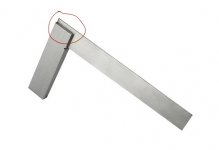Does anyone know the purpose of the lip on a try square? On ones with markings, it's a lot easier to use a thinner piece to find the right mark. However, on machinist or wood try squares, it seems that if the stock and blade were flush, it could be used as a saddle square as well.
Purpose of a lip on try squares
- Thread starter misha
- Start date

